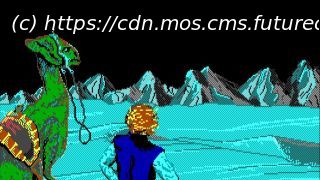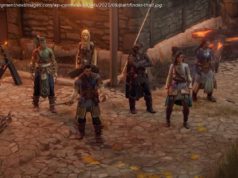Talking to Quest for Glory’s creators about three decades of videogame evolution.
The first two Quest for Glory games enjoyed the doubled-up input options of a text parser as well as a rudimentary point-and-click interface. You could right-click on a tree or a moose head to examine it, and sometimes be rewarded with a paragraph of pun-soaked description. But you could also reach over to your keyboard and start typing CLIMB TREE or GET MOOSE.
Some things could only be handled via text, like conversation. Shortcut keys made this less agonizing to use than it sounds. Ctrl-A was « ask about » so if you wanted to ask a centaur farmer about brigand attacks in the region you’d type « Ctrl-A brigands » and they’d tell you what they knew. Ctrl-T was « tell about », but people rarely cared what you told them. Most conversational progress was made by asking. There’s probably a lesson there.
The Quest for Glory games were originated by the wife-and-husband duo of Lori and Corey Cole between 1989 and 1998, who returned to videogames in 2018 with Hero-U: Rogue to Redemption, followed by the Summer Daze visual novels, all funded via Kickstarter. Over the years they’ve been part of so many innovations in the way games are made and played, I feel like all I need to do is hit Ctrl-A and type « CD-ROM replacing floppy disk » or « transition from dungeon crawls to narrative RPGs » to get a chapter of history out of them.
Quest for Glory came about because Richard Garriot left Sierra and took the Ultima series with him. Sierra had published Ultima 2: The Revenge of the Enchantress in 1982, which had a time-travel gimmick but was mostly about killing people who were in your way. Sierra was known for adventure games, but wanted to keep its hand in the RPG market as well. The Coles were expected to make a game like Ultima 2, only using the Sierra Creative Interpreter—the same toolset used to make King’s Quest 4.
« I spent that first year working with the internals of the SCI system, » Corey explains, « and I said, ‘We could do an Ultima game, but your system isn’t really suitable for it. Why don’t we try what we do at the roleplaying table? Because we don’t play all-combat games, we have storytelling games and your adventure games are a lot like that.' »
The end result was 1989’s Hero’s Quest: So You Want to Be a Hero (as it was known before a videogame version of the HeroQuest board game necessitated a renaming to Quest for Glory). Hero’s Quest had stats and skills that went up as you used them, and three playable classes: fighter, magic user, and thief. It had puzzles that could sometimes be solved by using your skills rather than combining a rubber chicken with a fake mustache or whatever, a non-linear story you stumbled across as you explored the woods around the town of Spielburg, and the option to export your character at the end to bring them back for the sequel just like you were playing a D&D campaign.Hard limits and soft disks
Though they conceived Hero’s Quest as a way to take advantage of SCI’s strengths, at first the Coles struggled to make the engine do what they wanted. « I had to rewrite the entire game because I had no clue of how to correctly do it with our engines and things, » Lori says. A lead programmer eventually sat down and detailed everything they couldn’t get away with. « Our games were always so much more complex than anybody else’s, » Lori continues, « because I want to give the player as many options as [possible] and be free rather than have them follow my directions to figure out what the game is. Our games probably would not have been created by any other company than Sierra because Sierra never, never took a look at what we were trying to accomplish and realized, ‘Oh, this thing is too expensive and a waste of time.' »
Corey is quick to butt in to mention one time someone at Sierra did shut down their ideas, however. While Hero’s Quest let the player choose a class, each of which could approach problems in different ways, the original plan was more ambitious. Rather than being limited to just a male human, they wanted players to be able to choose whether they were a man or woman, as well as a species like human, gnome, or centaur, with each one attached to a specific class. Programming manager Bob Heitman nixed that idea.
Corey explains. « First thing Bob said is, ‘OK, let’s look at this first scene. You have Spielburg, you’ve got some steps going up to a building. Have you thought about what will happen with our animation system if you try to animate a quadruped character going up those steps? It’ll be a disaster or look like hell. And you can’t just flip it around to have them come down the steps. It’s a different motion.’ He said forget the centaur. Then as far as the male and female character, he says, ‘OK, for every action you have, whether you’re climbing or throwing or picking something up, you need to have double the sets of animation.’ And most of that animation had to go on every floppy disk in the game, because a lot of players back then still actually played directly off the floppies without loading it on a hard drive. »Get lamp, drop parser
Which is why the text parser eventually had to go. While 1990’s Quest for Glory 2: Trial By Fire kept the combination of mouse and keyboard controls, and was able to understand verbs like mount, dismount, sneak, sit, stand, search, jump, climb, oil, and bargain, by the time Quest for Glory 3: Wages of War and a VGA remake of the first game came out in 1992, both could be played purely point-and-click.
Home
United States
USA — software From floppy disks to the crowdfunding revolution, adventure RPG pioneers Lori and...






